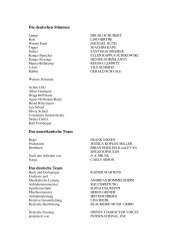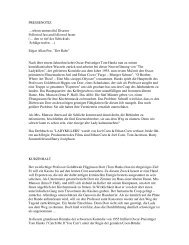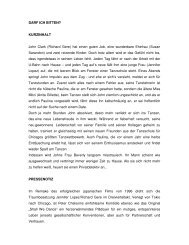SAHARA production notes FINAL
SAHARA production notes FINAL
SAHARA production notes FINAL
Create successful ePaper yourself
Turn your PDF publications into a flip-book with our unique Google optimized e-Paper software.
Cameron also was charged with designing a cave that tells the whole history of a<br />
Tuareg tribe in wall paintings. “It goes from 1,000 years ago up to the present day,”<br />
Cameron says.<br />
But for Cameron, one of the most interesting challenges involved designing the<br />
exotic location of Virginia, USA (or, at the time, CSA). “The opening of the film is a Civil<br />
War battle on the James River,” he <strong>notes</strong>. “We designed the Ironclad, of course, and it<br />
was interesting to create that battle and then move the Ironclad to the middle of the<br />
desert.<br />
“We had to get it into a sand dune, which sounds fairly easy on the surface,”<br />
Cameron continues, “but when you start moving hundreds of tons of sand and try to<br />
build into sand dunes, the sand shifts all the time. It becomes quite a major construction<br />
job. Even just crossing the desert was an enormous undertaking – a distance that might<br />
normally be covered in 15, 20 minutes can take a couple of hours.”<br />
Though spring in the desert is particularly welcoming – cold at night, pleasantly<br />
hot during the day, with a freshness not evident in the rest of the year – still, during the 12<br />
weeks of <strong>production</strong> in Erfoud, the filmmakers faced the difficult environmental<br />
conditions that go hand-in-hand with the harsh terrain.<br />
A common problem for film crews shooting in the desert is a sudden sandstorm,<br />
and “Sahara” was no exception. “We could have a beautiful morning at 8:00 a.m.,” says<br />
McConaughey, “and by lunch, we’d be in the middle of a sandstorm. You see it coming<br />
over the horizon, and it just hits. We would have about 30 yards of vision and that’s not<br />
even as bad as it gets. When they get really bad, you have about three or four feet.”<br />
Cameron concurred. “We would be constructing our sets and we’d be able to see<br />
clearly for miles and miles. Ten minutes later, I wouldn’t be able to see my hand in front<br />
of my face. And it’s hot. Standing on the dunes, it’s 120 degrees.”<br />
“I’ve always thought that Hollywood movies exaggerated the effects of<br />
sandstorms,” says Eisner, “but I must say that a sandstorm coming up is an impressive<br />
13

















